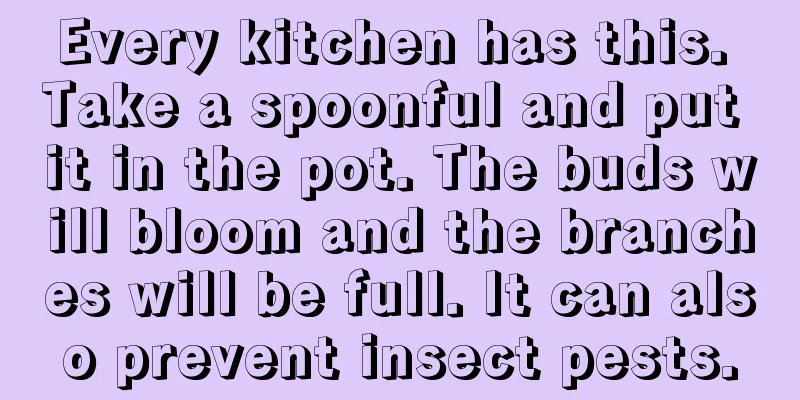Planting methods and management points of Giant Rose grapes

|
Giant Rose grapes are a medium-ripening grape variety that has been bred. The skin and flesh are easy to separate, have few seeds, and have a unique rose scent. It can be planted as a mid-ripe variety. Today I will introduce to you the planting techniques and management points of giant roses. 1. Giant Rose Grape Planting Technology 1. Build facilities A single-arm fence frame is used, with cement columns as uprights, one column is set up every 5m, the frame is 2m high, and 4 iron wires are pulled on the frame surface. The distance between the iron wires and the ground is determined according to actual conditions. After the facilities are set up, steps such as digging ditches, making ridges, irrigation, and applying base fertilizer are essential and need to be adapted to local conditions. 2. Planting Choose high-quality seedlings, plant them densely first and then sparsely. The planting density is determined according to the actual situation, 160-180 plants/mu, or 220-250 plants/mu. The main vine needs to be cultivated in the year of planting, and after planting, the shoots, ears, yield and leaves need to be determined. 3. Fertilizer and water management After the seedlings germinate and grow to about 30cm, when the first tendril appears, start topdressing and watering. Apply 10kg of chemical fertilizer per mu, once every 25 days or so, for a total of 4 times. Apply urea for the first two times and triple compound fertilizer for the last two times. Water once after each fertilization. In addition, nitrogen should be controlled and potassium should be increased appropriately. The medium soil fertility should contain about 30 kg of pure nitrogen and about 40 kg of potassium oxide. Supply water according to the phenological period and combine fertilizer and water. 4. Pruning Adjust the inflorescence before flowering, remove the secondary spikes, pinch off 1/4 of the spike tip, and cut off several larger stalks at the top. When the fruits are as big as soybeans, thin them out and remove the deformed, diseased, insect-infested, and injured fruits, leaving 60 fruits per ear. In winter, leave about 1000-1200 branches per acre, about 80% of which are pruned at 6-7 buds, and about 20% are pruned at 3 buds, leaving about 7000 buds per acre. 5. Pest and disease control It is necessary to prevent and control diseases and pests such as grape downy mildew, grape black pox, grape white rot, and grape two-star leafhopper in advance, and spray pesticides on diseased plants in time. 2. Key points for managing Giant Rose grapes 1. Current year management 1. After the seedlings germinate and grow to about 30cm, when the first tendril appears, start topdressing and watering. Apply 10kg of chemical fertilizer per mu, once every 25 days or so, for a total of 4 times. Apply urea for the first two times and triple compound fertilizer for the last two times. Water once after each fertilization. 2. After germination, when the new shoots grow to 5cm, select one healthy new shoot for cultivation and pinch off the rest to promote the growth of the main trunk. When the new shoots grow to about 35cm, insert a bamboo pole into each plant and tie the new shoots to the pole. When the new shoots grow to about 95cm, pinch off the top at 90cm. After pinching off, only keep the two lateral shoots at the top, and pinch off the top repeatedly after leaving three leaves. The tree can be cultivated in October of the same year and bear fruit the following year. (II) Management during the new shoot period 1. Remove buds and fix the tips. Remove the buds after germination. First remove the twin buds, secondary buds and buds on the main trunk, and then remove the excess buds at a standard of leaving one new shoot every 15 cm or so. 2. Pinching and handling of side shoots. Tie up the new shoots and pinch off the tips when they have 2 leaves. After pinching, keep one lateral shoot at the top and let it continue to grow. When the new shoot grows to touch the ground, lightly pinch it 50 cm above the ground. Later you just need to erase the side shoots. (III) Management during the flowering and fruiting period 1. Adjust the inflorescence before flowering, remove the secondary spikes, pinch off 1/4 of the spike tip, and cut off several larger stalks on the top. 2. When the fruits are as big as soybeans, thin them out and remove the deformed, diseased, insect-infested and injured fruits, leaving 60 fruits per ear. (IV) Water and fertilizer period management 1. After pinching the new shoots and before flowering, apply 20kg of triple compound fertilizer per mu and then water once more. 2. From bagging to the fruit hardening stage, apply 20kg of triple compound fertilizer per mu and then water heavily once. (V) Disease and Pest Control 1. Scrape off the rough, old and peeling skin every year. 2. After germination, when the new shoots grow about 4 leaves, spray 10% imidacloprid 1000 times diluted + 25% highly effective chlorfenapyr 1000 times diluted to control green stink bugs. 3. After bagging, spray 80% of the necessary 300 times liquid to prevent leaf diseases. That’s it |
<<: Planting methods and techniques of Sunshine Rose grapes
>>: When is the right time to plant chives?
Recommend
What kind of pot should be used to plant Desert Rose?
1. Choose a pot There are many kinds of pots made...
Does the bougainvillea baolao bloom frequently?
Baolaocheng is a common variety of Bougainvillea....
Add two drops of wax to the dying flowers with yellow leaves, and new buds will sprout!
Add some wax to the flower, and it will come back...
How to take care of the newly bought lucky charm
1. What to do with the product after you buy it? ...
The difference between Blue Enchantress and Blue Rose
From a genetic point of view The blue rose is a g...
Why do cyclamen flowers fall over?
Too much watering Generally, when the flowers of ...
Should I use a large or small pot for blue snow flowers?
Should I use a large or small pot for blue snow f...
How to grow azalea at home
Rhododendron Growing Conditions Rhododendron pref...
How to sow Begonia
1. Choose a container For Begonia, you should cho...
How long is the growth cycle of spinach?
Introduction to Spinach Growth Spinach is suitabl...
If you water like this, it would be strange if the flowers died.
How to judge whether it is time to water? look Ch...
Causes and remedies for yellowing of Spathiphyllum leaves
1. Reasons 1. Improper lighting: The growth of Sp...
Why are the leaves of Strelitzia reginae curling?
1. Excessive fertilization 1. Reason: Strelitzia ...
The symbolism and significance of Paphiopedilum's flower language
The flower language and symbolic meaning of Paphi...
How to keep roses alive (how to grow roses easily and well)
Roses are relatively easy to grow, and it is not ...









